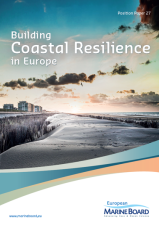
Building and enhancing resilience to pressures requires coastal social-ecological systems that can persist, adapt or transform while maintaining their essential functions to deliver ecosystem services for both nature and people. This document provides an overview of concepts and frameworks for building coastal resilience, along with a six-step approach for their use in coastal management, and an overview of the key pressures facing European coastal social-ecological systems and their impacts, including knowledge gaps for individual pressures, their combined effects, and tipping points at which a transition to a new state is triggered. Tools for building coastal resilience, with a specific focus on coastal protection and Nature-based Solutions, as well as barriers and enablers to their implementation are also described and three case-studies across Europe are presented: the Maharees Peninsula, Ireland; the Venice Lagoon, Italy; and the Belgian Coast to demonstrate key concepts. While this Position Paper specifically focuses on the European continent, including the United Kingdom and other non-European Union countries, and does not specifically include the European Union outermost regions, the conclusions and recommendations may also be applied to other regions.
You can find the news item about the document launch here, infographic summaries of scientific recommendations here, policy recommendations here and coastal pressures here, and more about the Coastal Resilience Working Group here. Note that these infographics are licenced under CC BY-NC-ND 4.0 and credit should be given to Amy Dozier when re-publishing.